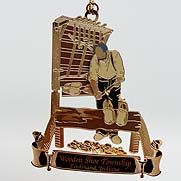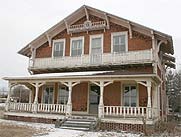2010 Essays: Honorable Mention— Courage and Tears The Fire at Ferdinand Furniture Company by Alex Luebbehusen
A memory of an event, although extremely important, fades over time. The breaking news of Thursday June 18, 1970, dissipated to such an extent that many of the youth may not have even heard of the tragic incident on that day. On June 18, 1970, The Daily Herald wrote, “The worst fire in the history of Ferdinand this morning completely destroyed the plant of the Ferdinand Furniture Company at Ninth and Missouri Street” (Fire 10). The story goes deeper than this stated text, though, to truly know the topic it would be necessary for that person to investigate into the incident until he or she can truly answer the question,“ What was significant about the fire at Ferdinand Furniture Company?”
The sheer normality of June 18, 1970, becomes almost eerie. The clock reads 8:40 a.m., and Ferdinand Furniture Company employees work quickly to get their product off the line (Factory 7). It takes only a second; a single spark falls from the ceiling of a finishing oven (Ferdinand 1). Quickly and violently, a small fire ignites from the accumulated dust on the factory floor (Ebert 396). Jerome Meier and Ervin Verkamp rush for bottles of carbon dioxide in an attempt to suffocate the flame, but their attempts prove futile and they only succeed in helping the flame spread. Within minutes, the fire spreads to the next section of the factory. It quickly becomes evident that this fire could get out of hand. Evacuation becoming their primary goal, all employees succeed in making it out safely. Art Ruhe, general manager of the company, leaves the building last. (Ferdinand 1-3)
Ferdinand Furniture Company existed on the corner of Eighth Street and Missouri Street (Ebert 396). Because of its close proximity to the fire department, two fire units arrived on the scene within minutes after the fire erupted (Ferdinand 1). After the firemen realized the daunting task that awaited, fire crews called in from Huntingburg, Jasper, Schnellville, Holland, Haysville, St. Anthony, and Dubois arrived on the scene to help fight the fire (Factory 7). Seen for miles around, the fire acted as a beacon for the rest of the town and alarmed people of the major occurrence (Fire 10). Citizens quickly flooded the streets, and it swiftly evolved into a scene of excitement and anxiety. The arrival of this many citizens in the street did not hinder the officials’ ability to work efficiently, though. In fact, residents mentioned that onlookers cooperated well throughout the whole ordeal (Ebert 397). A few groups, including the Ferdinand Fireman’s Auxiliary, even went as far as serving food and drinks to the weary firemen (Fire 10).
As time drew on, matters quickly escalated. Preventing the spread of fire to surrounding areas and buildings soon became the top priority once firemen realized that much more lay at stake than the factory itself (Factory 7). As a safety precaution, four families evacuated from nearby homes (Fire 10). In retrospect, this idea could have saved lives if the event would have gotten any worse. Temperatures reached such an intense heat at the nearby residence that one of his windows actually melted (Factory 7). Maybe most notable, Vincent Gudorf’s house received damage to its roof and a storm window completely shattered (Fire 10).
Why did the fire advance this quickly? The factory’s combustible materials, used in different furniture-making processes, along with a brisk wind caused the small fire to become a blazing inferno (Factory 7). From the early stage of the fire, firefighters dealt with the continuous nuisance of gas lines catching fire (Ebert 396). The factory also contained steel drums of finishing material. This finishing material had highly combustible properties and tendencies to launch their steel drums up into the air as projectiles. These steel drums—launching, at times, up to 250 feet in the air—posed dangerous risks. One landed a mere 50 feet away from a fire truck. (Ferdinand 1) Brisk winds from the southwest only fed the fire the air on which it thrived (Ebert 398). The high winds and combustible materials combined to make the Ferdinand fire spread as quickly as it did.
One of the many heroes of that day, Chief Jackson, deserves mentioning for the valor and courage he displayed while fighting the fire. In the early stages of the blaze, a six-inch water main ruptured. This resulted in a drop in the water pressure to the hydrants needed for extinguishing the blaze. Realizing the need for the water pressure, Chief Jackson, under a stream of water and with smoke billowing all around him, crawled to shut off the valve. These actions allowed the task of fighting the fire to continue efficiently and effectively. (Ferdinand 1)
Chris Luebbehusen, an eyewitness to the event and a child at the time, recalled the events on June 18. “We were home playing outside. We saw the black smoke column and then saw fire trucks coming into town from either Dale or St. Meinrad to help out.” Along with his mother, he walked up the street accompanied by some of their neighbors in attempt to get a better view of the unfolding events. They watched the excitement from what is now Henry Haake’s front yard. What he witnessed remains sharp in his mind to this day. Of the many memories he had from that day, he recalled two main occurrences in particular: the column of black smoke and the exploding barrels. In recollection, he stated, “I was very young at the time, but it was the biggest fire I have ever seen. I don’t believe I have seen a larger one since.” (Luebbehusen 1)
The firefighters—after three hours of intense effort—succeeded in controlling and stopping the fire (Ebert 400). The extent of the monetary value lost became evident shortly after the smoke settled. Ferdinand Furniture Company sustained 1,000,000 dollars in damages (Fire 10). Not only did the company lose a large quantity of money, but 125 employees no longer had a place to work (Ebert 400).
Questions rose about the available water supply Ferdinand had access to during the fire. While fighting the blaze, fire crews used all five available hydrants in the surrounding area. (Ferdinand 2). Some estimates stated that 400,000 gallons of water doused the flames even before noon that day. Such an influx of water combined with its expenditure over such a length of time caused much concern. To the town’s relief, Ferdinand never encountered any real danger of running out of water. (Ferdinand 1) Ferdinand’s system had the capabilities of drawing water from two separate lakes (Fire 10). Combined, these two lakes gave Ferdinand a reserve of about 500,000 gallons. In addition to the lake source of water reserve, a local water tower held approximately 80,000 gallons; the capabilities of their system also allowed Ferdinand to filter 140 gallons per minute. Ironically though, the colossal output of water did not extinguish the blaze, but instead nature immersed the flame. Rain extinguished whatever small fires still remained on the following Saturday. (Ferdinand 1-3) In an effort to allay the town’s growing need for water and for added assistance for any future fires, another water tank was constructed in 1983. Massively increasing the town’s water reserve, the water tower allowed water protection on both the east and the west side of town. (Ebert 402)
That week’s Ferdinand News article described the event as “the worst fire to hit Dubois County.” The article later covered the value of Ferdinand Furniture Company by saying, “Far-reaching values of such a business to a community are hard to estimate. Besides the payroll and contributions, they are large customers of local utilities, taxpayers, building contracts, the large fleet of trucks which were purchased and serviced locally, etc.” (Ferdinand 1-4) The massive fire at Ferdinand Furniture Company greatly influenced Ferdinand economically and unified the surrounding area. From losing a job to risking one’s life to gaining a childhood memory, everyone in the town of Ferdinand felt the effects of the fire in someway. A fire and the effort that accompanied it do not deserve to be forgotten, and therefore, hold significance in Ferdinand history that hopefully will never become faded with the years.



